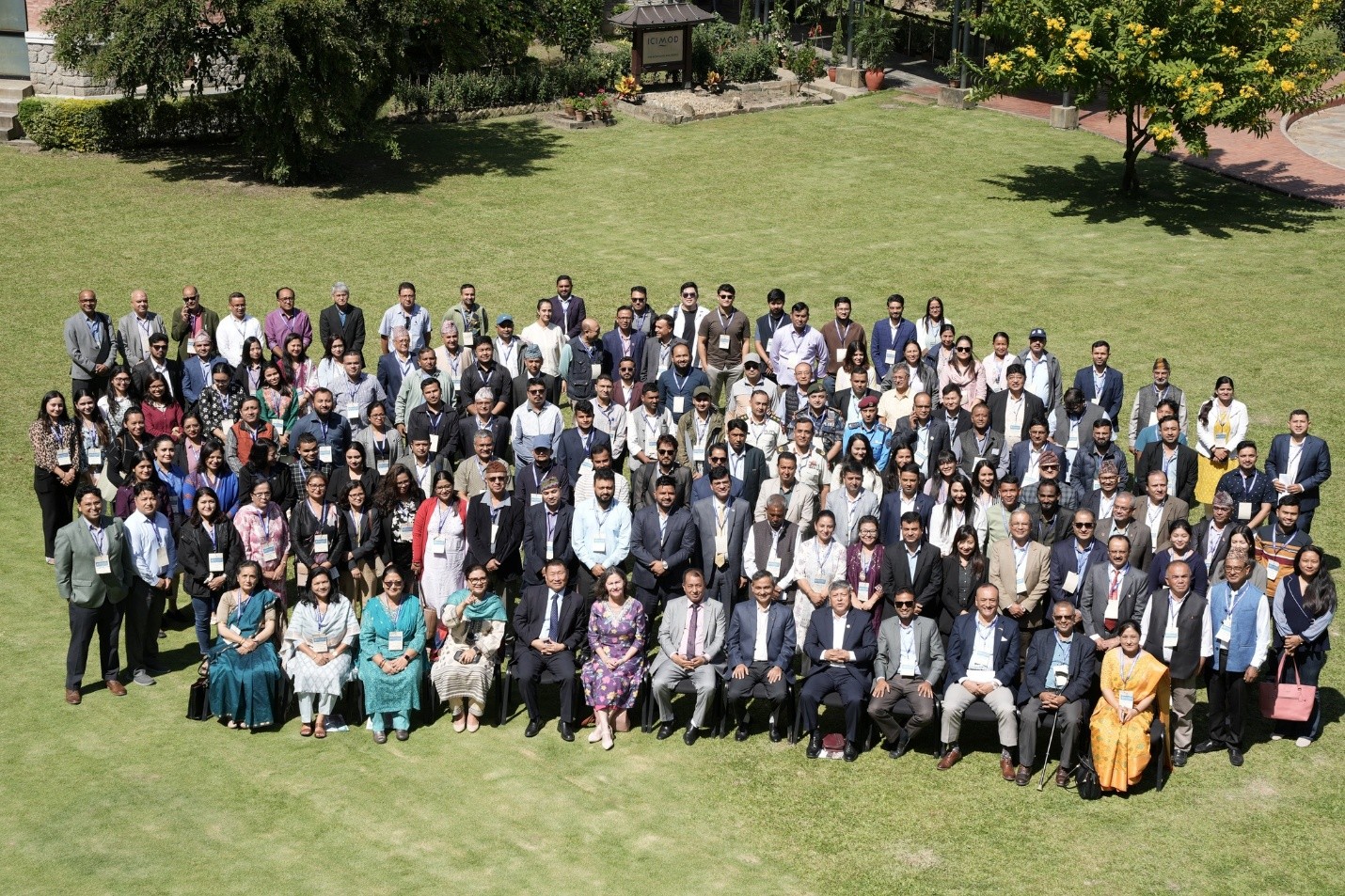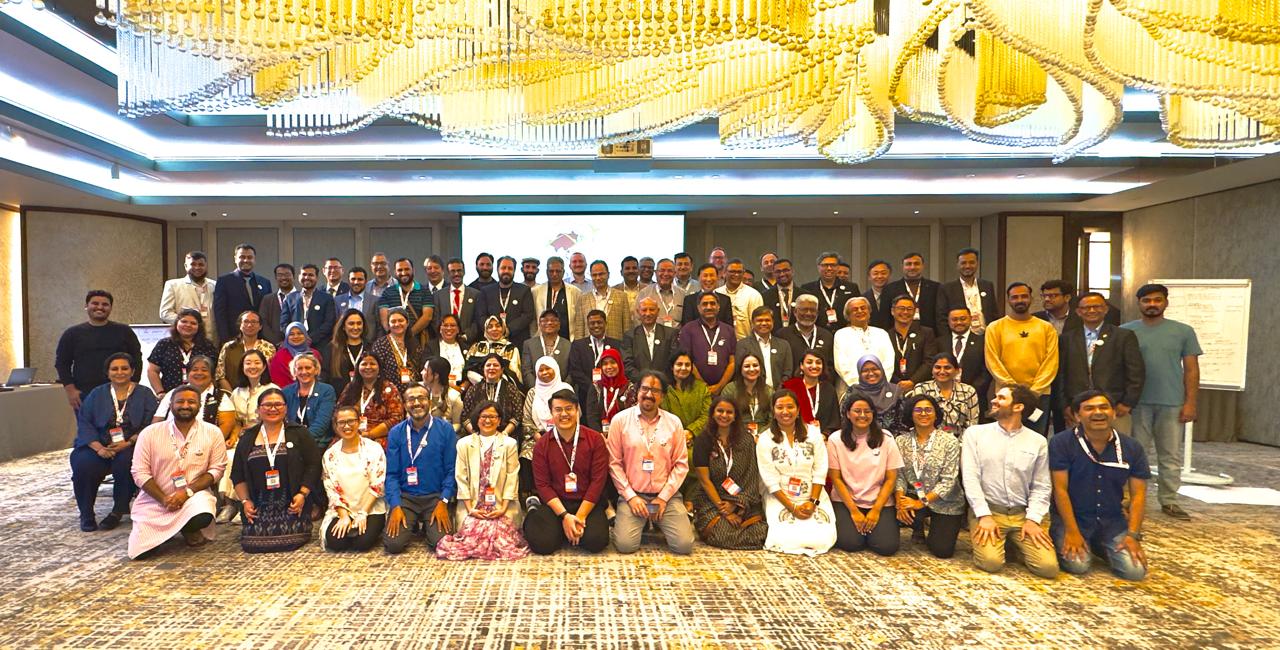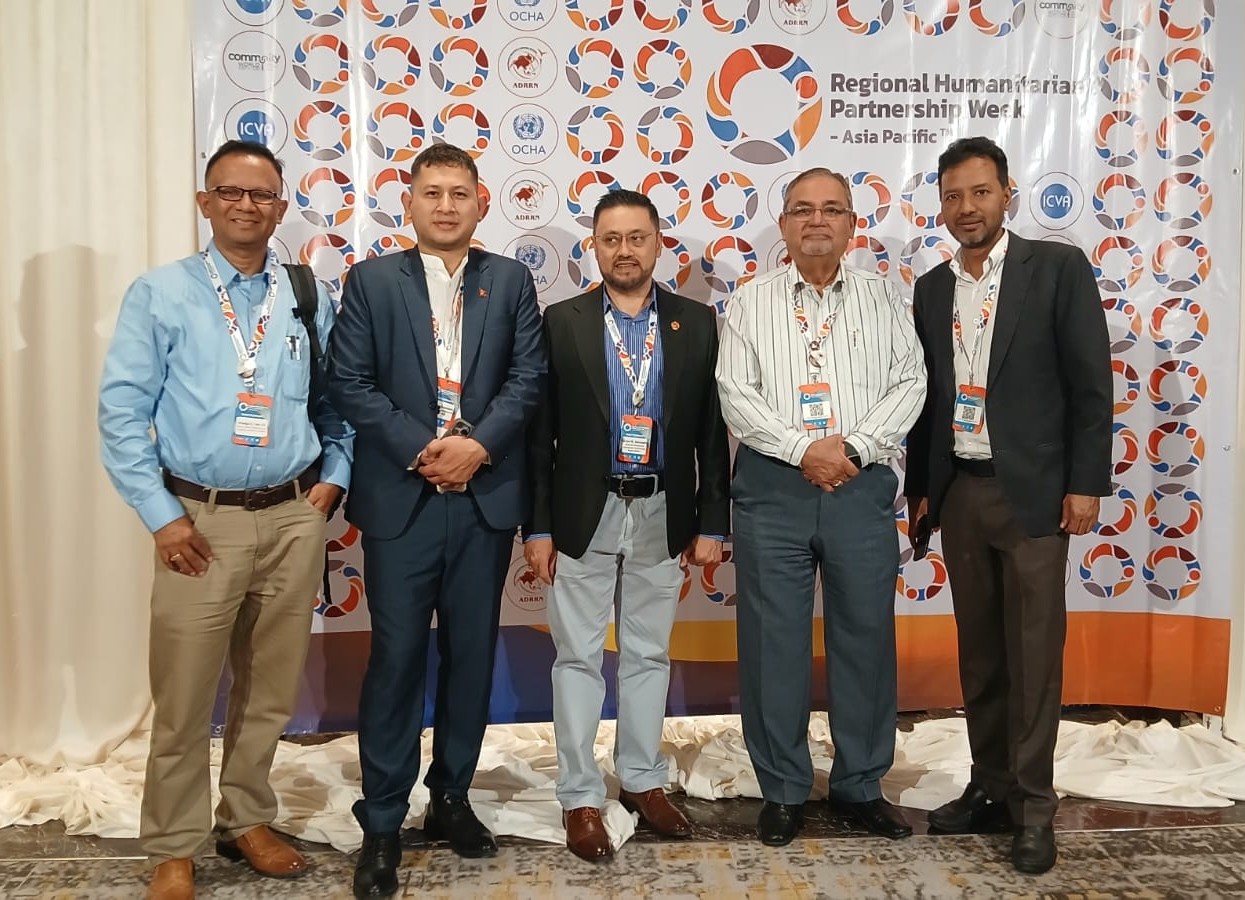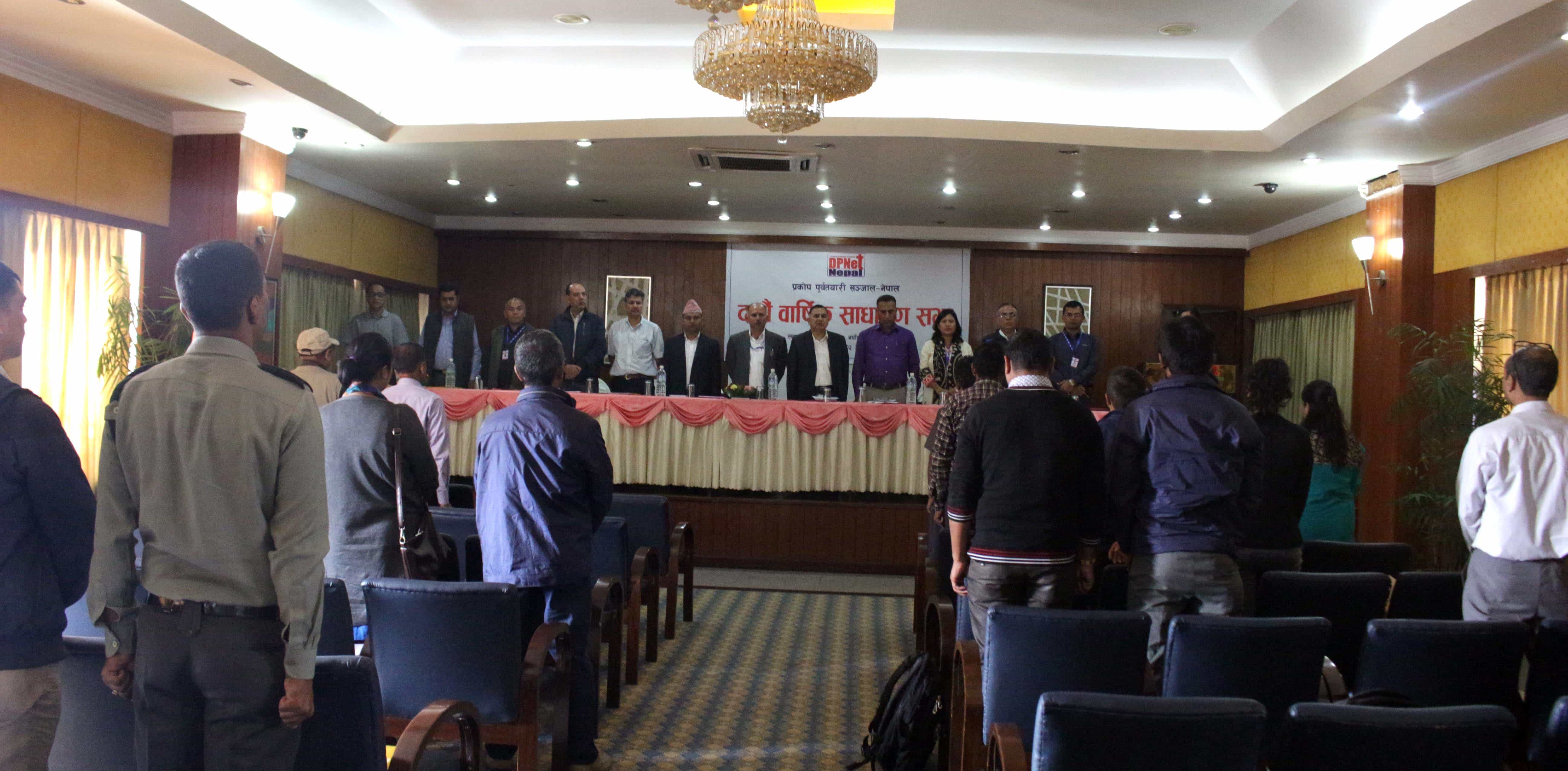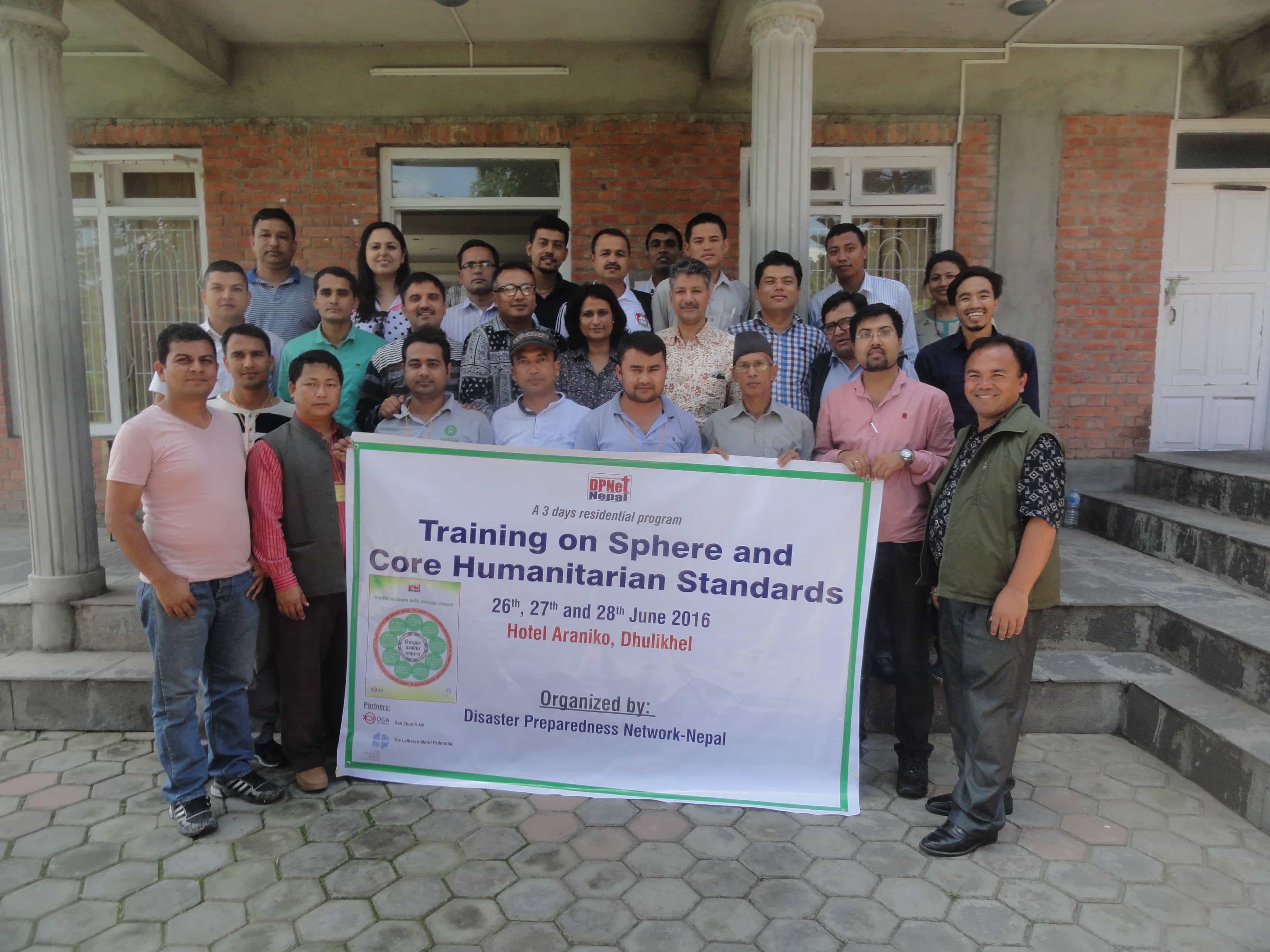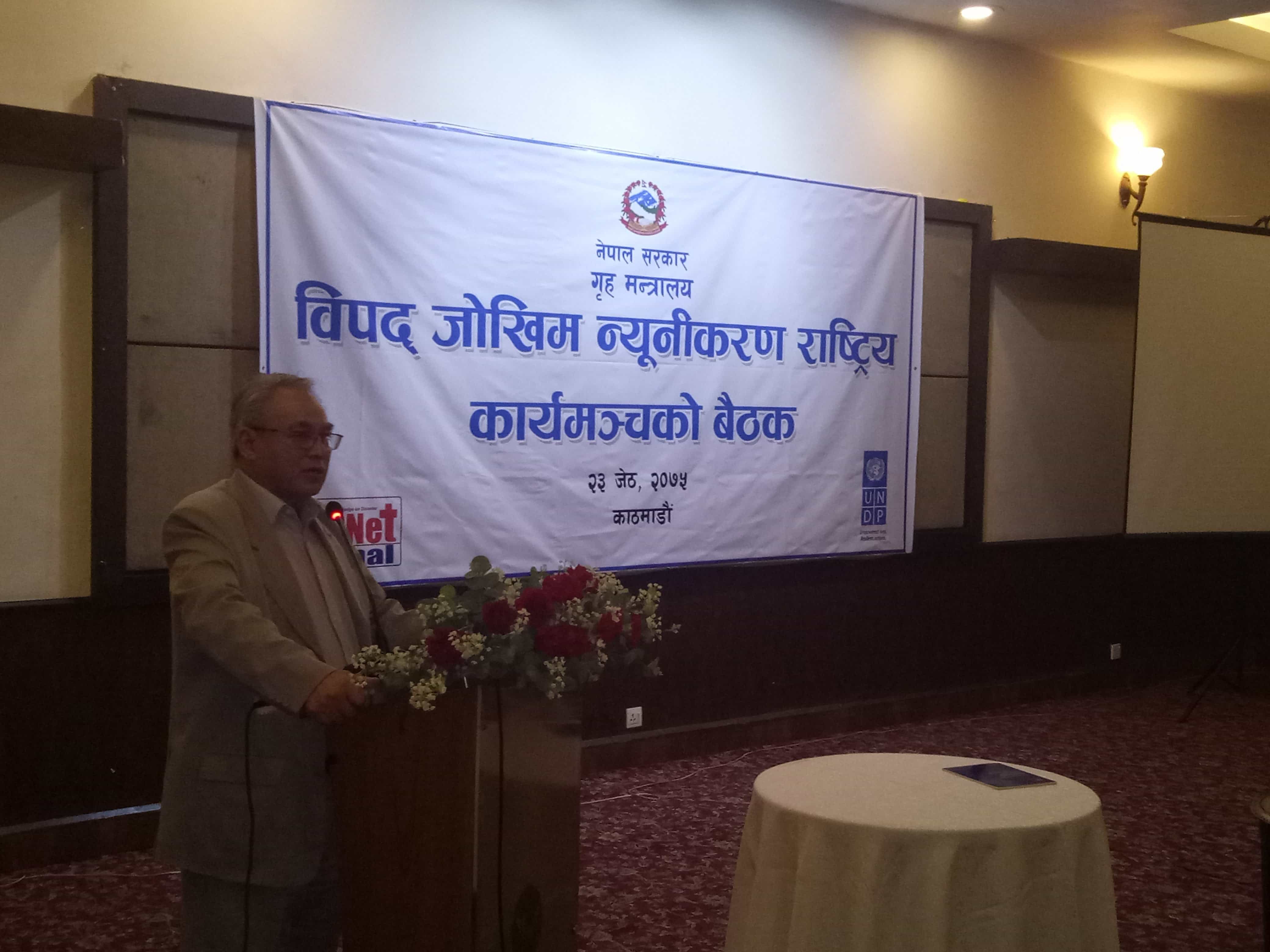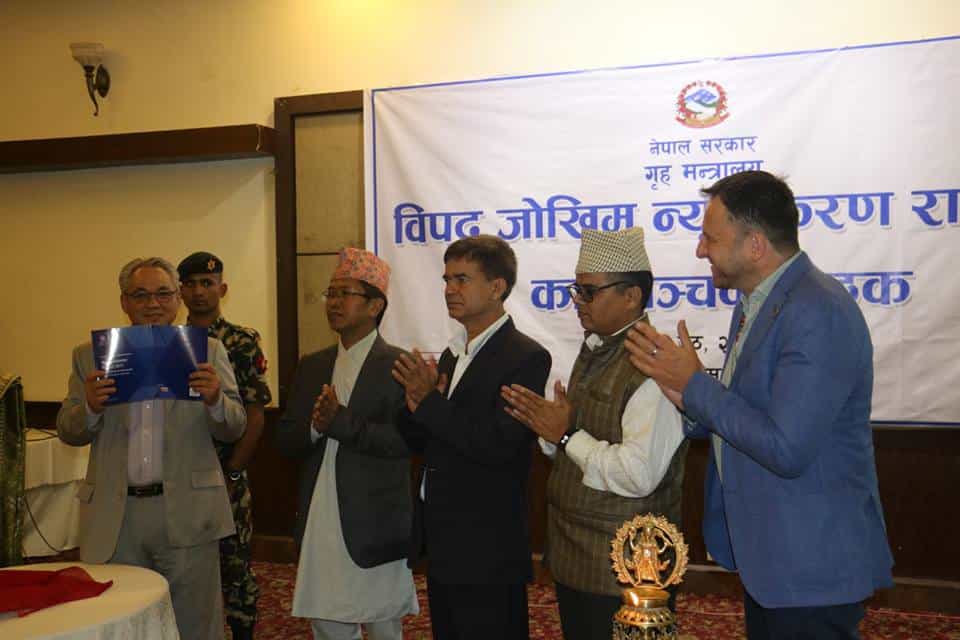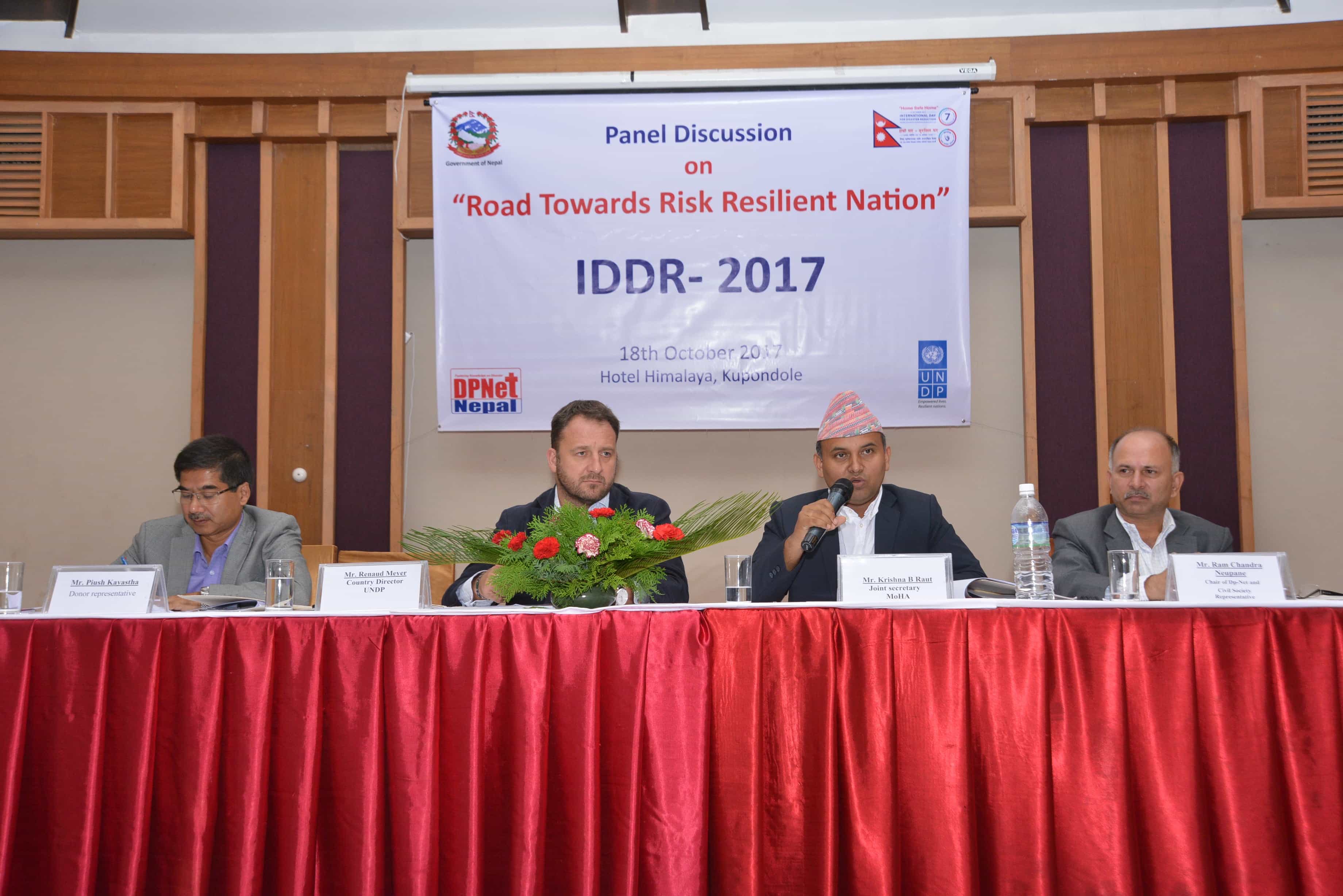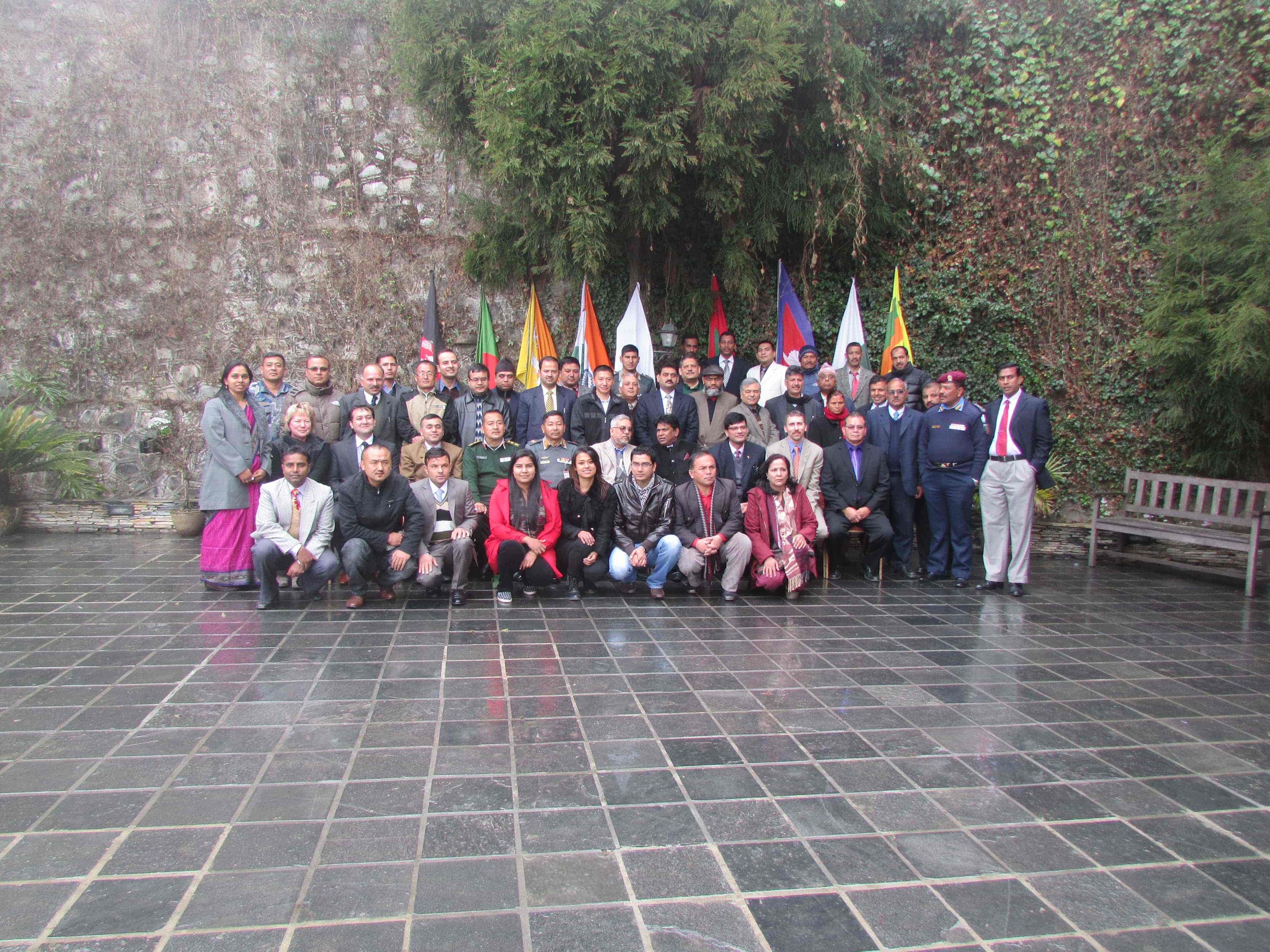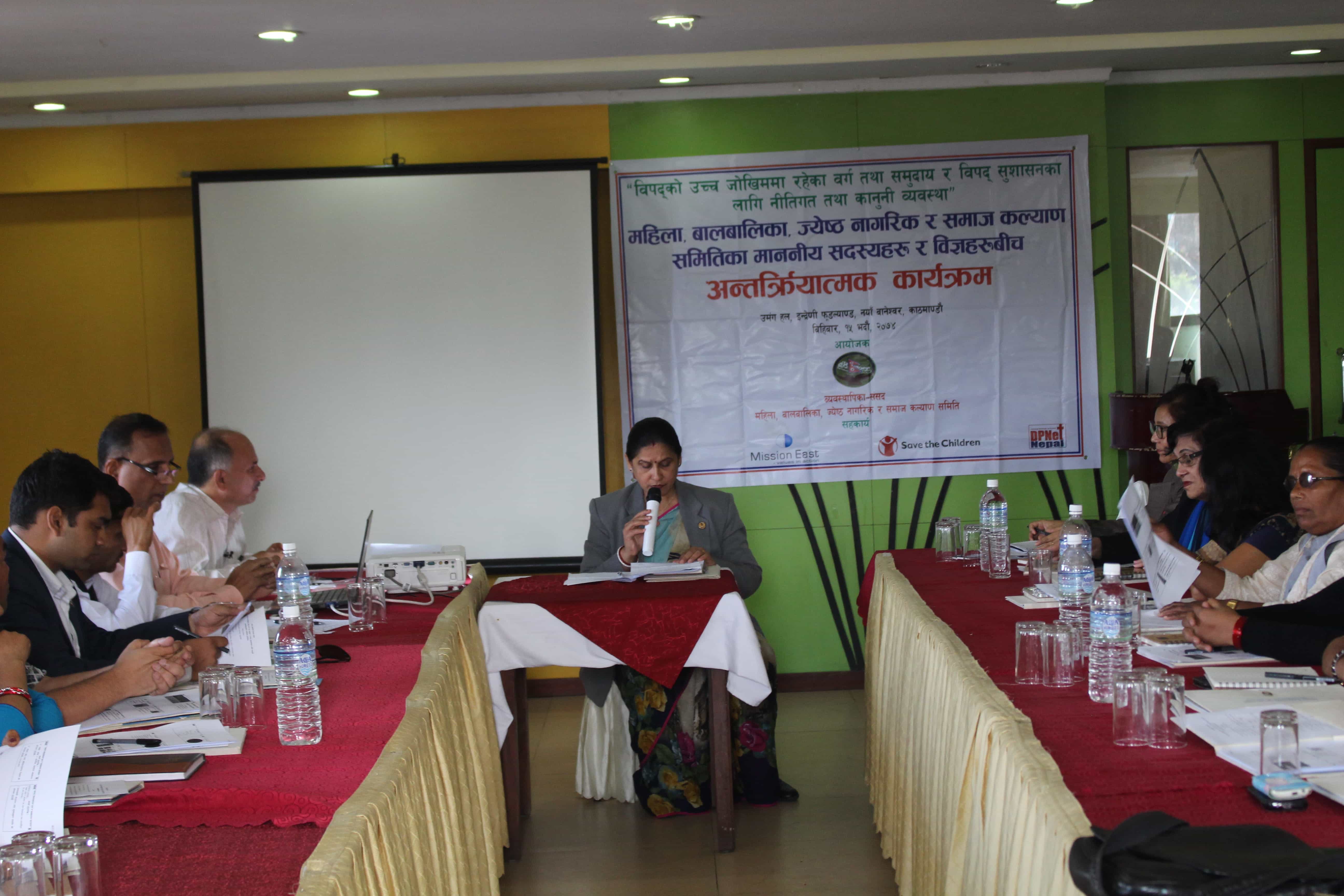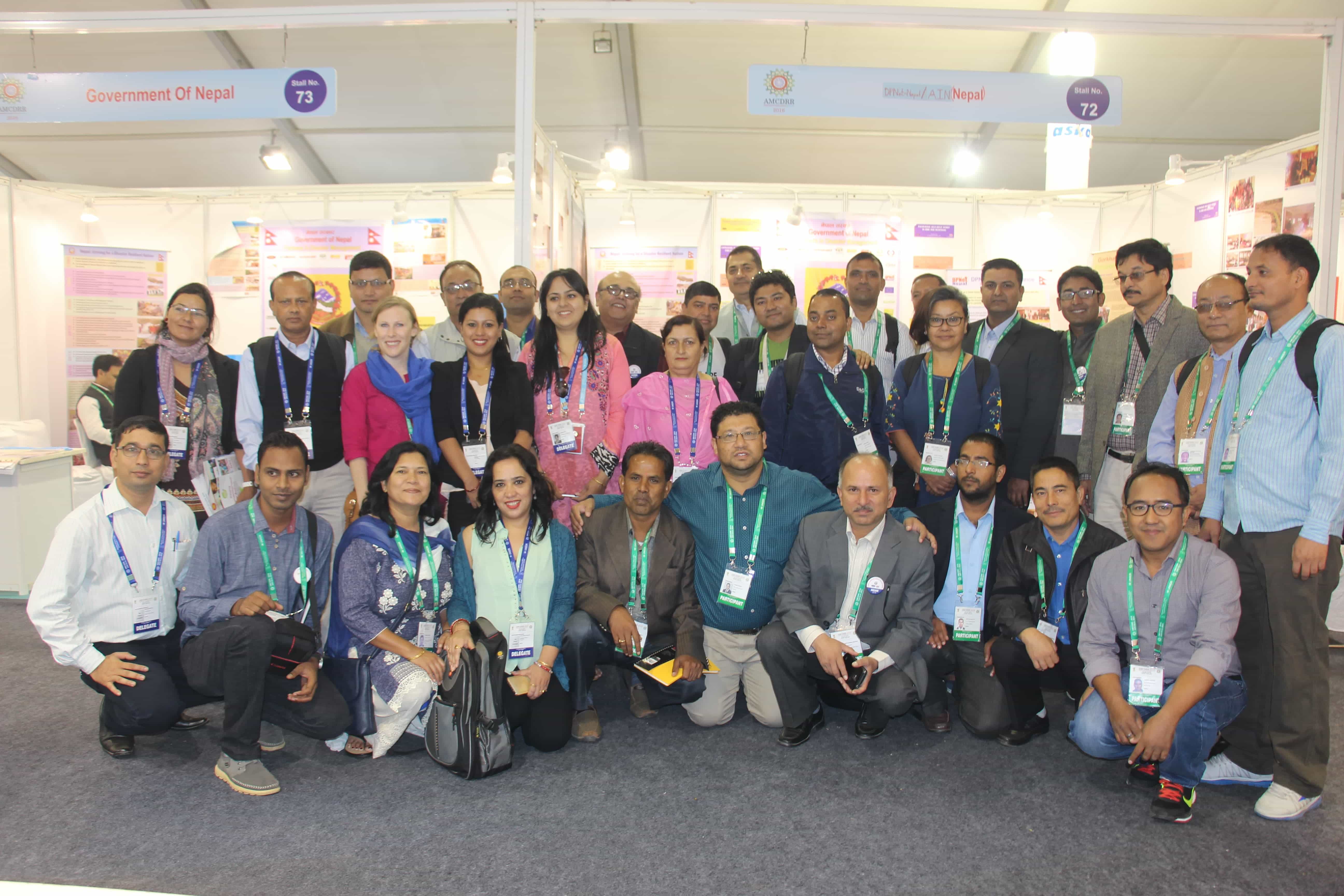Koshi Province Monsoon Preparedness and Response Plan 2081 Workshop
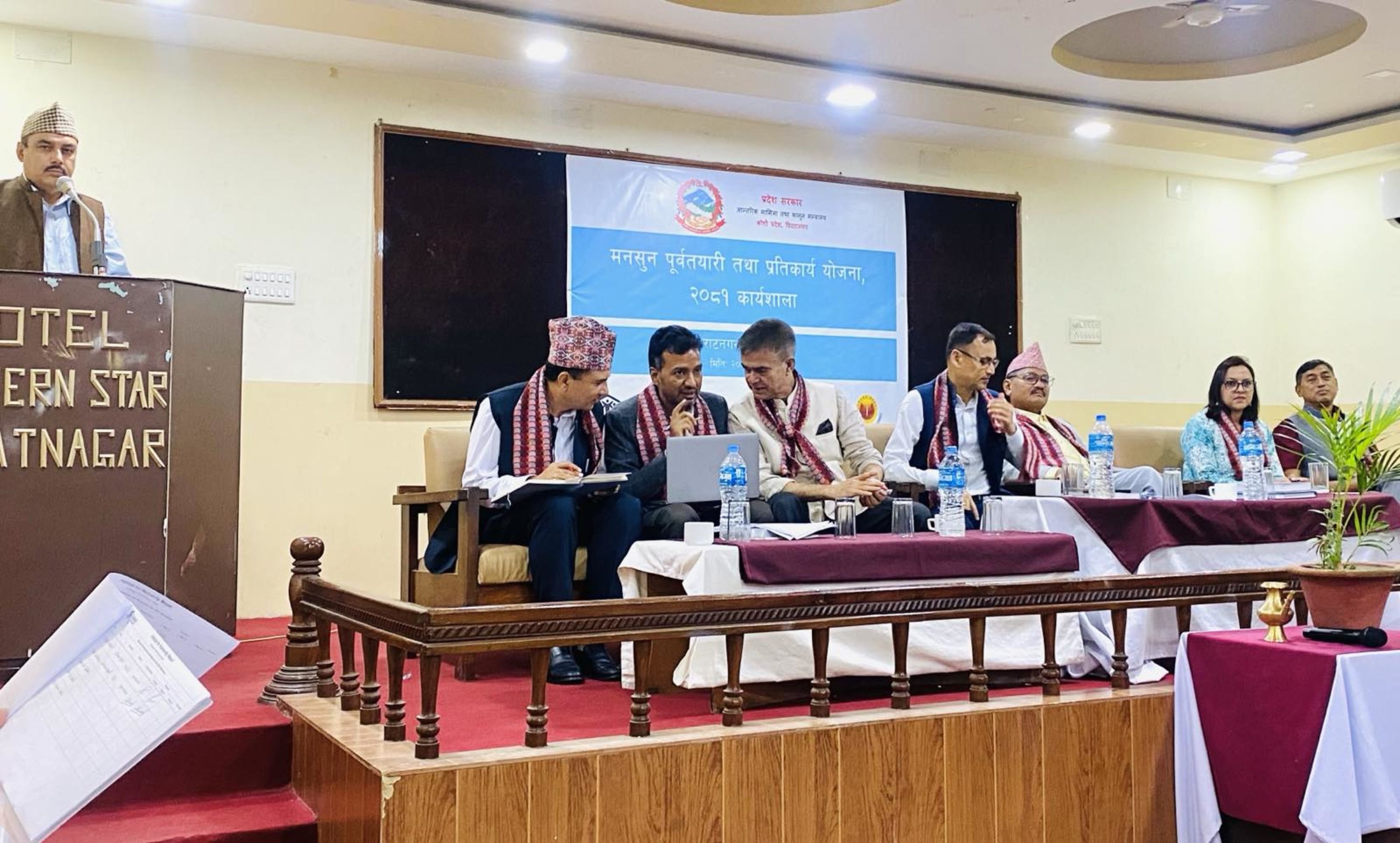
On May 12, 2024, the Ministry of Internal Affairs and Law (MoIAL) in Koshi Province organized the Monsoon Preparedness and Response Plan 2081 Workshop, with collaborative support from DPNet Nepal, Habitat for Humanity Nepal, Nepal Red Cross Society, and SAHARA Nepal. Mr. Laxmi Prasad Poudel, Secretary of MoIAL in Koshi Province, chaired the event, while Minister Ram Bahadur Magar graced the occasion as the Chief Guest. The program was facilitated by Mr. Surya Bahadur Thapa, the immediate past president of DPNet. Minister Magar inaugurated the proceedings, which drew the participation of 75 attendees, comprising stakeholders and representatives from various organizations and sectors.
Mr. Kedar Neupane, DPNet Nepal Advisor and Former Secretary of the Government of Nepal highlights the objectives of the program sharing insights gathered from his tenure as Chief Secretary of Koshi Province, where he encountered multiple instances of monsoon-related events. He emphasized the critical role of the Koshi Province as the primary gateway for the monsoon's entry into Nepal. Neupane elaborated on the challenges posed by the province's extensive network of rivers and the presence of dry rivers, particularly when faced with heavy rainfall. He highlighted the dual nature of the Koshi River and its tributaries, which not only provide opportunities for the local population but also present significant challenges during monsoon seasons. Neupane stressed the importance of developing a comprehensive preparedness and response plan to mitigate the impact of monsoon-related disasters in the region. His remarks highlight on the necessity of addressing the unique vulnerabilities and opportunities inherent in the Koshi Province's geographical landscape, emphasizing the need for collaborative efforts to ensure the resilience of local communities in the face of monsoon related disasters and shared that the program will help to build consensus to make the remarkable monsoon preparedness and response plan.
Mr. Kamal Thapa, Spokesperson of the Ministry of Internal Affairs and Law (MoIAL) Koshi Province, highlighted on the existing challenges in implementing disaster management policies within the province, attributing the primary obstacle to resource scarcity. Drawing attention to the catastrophic Sankhuwasabha flood of June 2023, Thapa highlighted its significance as a dark reminder of the vulnerability of Koshi Province to climate-induced monsoon-related disasters. He emphasized that while the province possesses adequate policy frameworks, the effectiveness of these measures is often hindered by the lack of sufficient resources for implementation. Thapa detailed the Sankhuwasabha flood, attributing its cause to heavy monsoon rains triggering landslides that obstructed the Hewa and Sabha rivers, leading to widespread devastation. He highlighted the flood's impact, including the loss of life, damage to infrastructure, and displacement of residents. Thapa outlined the consequential damages, such as the destruction of hydropower projects under construction and the washing away of houses and a crucial bridge, critical infrastructure like a water pump project supplying drinking water to households was also severely affected. Using the Sankhuwasabha flood as bitter example, Thapa emphasized the imperative of incorporating extreme case loads into the formulation of monsoon preparedness and response plans. He stressed that such considerations are essential to prevent chaotic conditions and effectively mitigate the adverse impacts of monsoon-related disasters in Koshi Province. Thapa called upon development partners to join hands in this endeavor, urging collaborative efforts from the initial stages of plan development to the implementation of response strategies. By engaging in comprehensive preparedness measures and coordinated responses, Thapa asserted that the negative consequences of monsoon-related disasters could be minimized, enhancing the resilience and safety of communities within Koshi Province.
Dr. Dijan Bhattarai, Spokesperson for the National Disaster Risk Reduction and Management Authority (NDRRMA), presented the initial draft of the Monsoon Preparedness and Response Plan prepared by the NDRRMA. He highlighted that while the monsoon outlook was about to introduce by the Department of Hydrology and Meteorology (DHM), the NDRRMA had yet to incorporate anticipated case loads and relevant strategies into the plan. Dr. Bhattarai emphasized several key areas that the Koshi Province government should prioritize in the plan, including resource management, delineation of responsibilities and contributions, establishment of relief and stockpiling mechanisms, sectoral case load analysis, assessment of co-lead agencies' capabilities, and formulation of resource management plans. He highlighted the importance of having a fully functional provincial emergency operation center, equipped with a provincial command center, to ensure effective preparedness and response measures. Dr. Bhattarai emphasized that careful consideration of these elements would be instrumental in crafting an effective and high-quality monsoon preparedness and response plan for the Koshi Province. By addressing these critical aspects, the plan would be better equipped to anticipate and mitigate the impact of monsoon-related disasters, ultimately enhancing the resilience and safety of communities within the region.
Mr. Suraj Gautam, DPNet's General Secretary, emphasized community engagement and resilience building in the plan to ensure holistic preparedness and highlighted the aspects that needs to be incorporated in the Monsoon Preparedness and Response Plan 2081. Mr. Gautam shared key strategies to reducing the disater risks. He particularly emphasized the use of engineering techniques to strengthen the resilience and adaptability of infrastructure systems. In addition to highlighting the significance of preparedness efforts for effective disaster risk reduction and management (DRRM), he emphasized the critical role of information management in these efforts. He provided insights into monsoon patterns, discussing historical data on monsoon duration and extreme weather events. Post-monsoon, Mr.Gautam drew attention to specific incidents of heavy rainfall leading to floods and landslides in the Koshi Province. He highlighted the importance of scientific analysis in estimating the potential impact on affected populations. Moreover, Mr. Gautam discussed various triggers for early action, citizen science initiatives, and effective risk communication and early warning messaging strategies, all aimed at enhancing community resilience and preparedness.
Dr. Dharam Upreti, Hydro-Meteorological Expert, presented that the implementation of people-centered, multi-hazard, end-to-end EWS had become an important approach to reducing the negative effects of natural catastrophes. These systems were essential for reducing damage to people, property, and livelihoods since they were made to initiate planned and thoroughly tested early measures. In 2021, the World Meteorological Organization (WMO) underlined that early warning saves lives and can limit damage by as much as 30% when given 24 hours in advance. One example of this was the significant decline in flood-related deaths in Nepal, which had been linked to the successful application of Flood EWS. He also highlighted that building on this success, organizations like Practical Action had worked with government agencies like the Department of Hydrology and Meteorology (DHM) to develop and improve flood EWS throughout Nepal’s various river systems. These initiatives, which involved migrating from manual to telemetry-based systems, had given community participation a top priority. This allowed warnings to reach and empower vulnerable communities. Additionally, initiatives have been made to move toward impact-based forecasting, which would allow for more accurate projections and focused responses. Acknowledging the wider range of natural hazards, efforts had been expanded to involve the piloting of landslide EWS in collaboration with agencies such as DFAT, especially in areas like Sindhupalchok district. Furthermore, activities like capacity-building have been carried out in partnership with organizations such as TAYAR Nepal to enable local governments to use EWS tools for disaster preparedness and response in an efficient manner. Furthermore, innovative techniques like incorporating EWS into index-based flood insurance plans highlighted how adaptable and successful these systems were.
He brought to light that in 2022, UN Secretary-General Antonio Guterres had called for early warning systems to protect every person on Earth within five years, and it seemed like a vital task. Strong and comprehensive EWS were becoming more and more necessary as climate projections showed above-normal precipitation in certain areas and below-normal levels in others. The pursuit of equitable and extensive early warning coverage was being facilitated by collaborative efforts and partnerships, with the ultimate goal of protecting lives and livelihoods from the capricious forces of nature.
Mr. Mean Kumar Aryal, Senior Divisional Meteorologist, Department of Hydrology and Meteorology (DHM), presented the weather forecasting, monsoon patterns, and their potential impacts in his presentation. Mr. Aryal highlighted Nepal's expansive array of monitoring stations, including synoptic and aero synoptic stations, rainfall and climate monitoring sites, real-time automatic stations, lightning detection networks, and weather RADAR systems. Despite these resources, Mr. Aryal underscored notable hurdles such as a scarcity of skilled IT professionals, challenges in communicating complex forecasts, and difficulties maintaining instruments in remote locals.
Looking forward, he stressed the significance of government investment and partnerships with development organizations and research institutes to effectively tackle these obstacles. He emphasized the necessity for bolstering technical expertise and allocating more resources for meteorological research and development. Aryal concluded that these initiatives are very important for enhancing Nepal's weather forecasting capabilities and mitigating potential weather-related impacts across the Province.
Workshop/Open Floor Discussion:
In the workshop/question-and-answer session, participants raised various critical issues concerning monsoon preparedness and response plans. One significant topic discussed was the implementation of forecast-based financing and cash transfer mechanisms, highlighting the importance of incorporating financial aspects into disaster response strategies. Participants emphasized that the preparedness plan should serve as a comprehensive guide for all stakeholders involved, ensuring a coordinated and efficient response to monsoon-induced disasters. Additionally, the prepositioning of heavy equipment and mapping out potential disaster-prone areas in anticipation of monsoon events were key points of discussion. Participants stressed the importance of proactively addressing challenges such as water management in hill areas to mitigate the risk of floods and ensure groundwater recharge. Concerns were also raised about the vulnerability of local governments, particularly Biratnagar Municipality, to monsoon floods despite being the provincial government headquarters. To manage flood risks effectively, participants emphasized the necessity for river training initiatives. Another prevalent issue discussed was the challenge of insufficient budget allocation for executing preparedness and response plans effectively. Many participants expressed the view that while comprehensive plans could be formulated, their effectiveness was often hampered by a lack of financial resources. Therefore, there was a unanimous call for provisions to be made for budget allocation when drafting such plans, ensuring that adequate funding is available for implementation.
Participants also discussed the need to identify and map areas most vulnerable to monsoon-related disasters, focusing on geographic and demographic factors to ensure accurate risk assessments. Enhancing coordination and communication between government agencies, non-governmental organizations, local communities, and international partners was deemed crucial for a unified approach to disaster preparedness and response. Ensuring sufficient resources, including financial, material, and human resources, are allocated for monsoon preparedness and response activities, with a focus on sustainable and equitable distribution, was another key recommendation. Improving the effectiveness and reach of early warning systems for floods and landslides, including the use of modern technology and local knowledge, was emphasized to ensure timely warnings to all at-risk populations. Strengthening the resilience of critical infrastructure such as roads, bridges, schools, hospitals, and other public buildings was also highlighted to reduce potential disruptions and damages. Encouraging the active participation of local communities in disaster preparedness and response planning was recognized as essential, acknowledging their valuable insights and fostering a sense of ownership and responsibility. Providing comprehensive training and capacity-building programs for local responders, community leaders, and volunteers on disaster response techniques, first aid, search and rescue operations, and emergency management was deemed important. Enhancing data collection, analysis, and sharing mechanisms to inform decision-making and response efforts, including real-time data on weather patterns, water levels, and affected populations, was also discussed.
Conducting widespread public awareness campaigns to educate the public about monsoon risks, safety measures, and the importance of preparedness using various media platforms to reach diverse audiences was recommended. Ensuring that the needs of vulnerable groups, such as women, children, the elderly, and people with disabilities, are explicitly addressed in the preparedness and response plan was emphasized, including tailored communication, evacuation assistance, and specific support services. Preparing healthcare facilities to handle the surge in medical needs during monsoon disasters by ensuring the availability of medical supplies, trained personnel, and emergency response protocols was discussed. Developing and regularly practicing evacuation plans for communities in high-risk areas, including clear evacuation routes, safe shelters, and transportation arrangements to ensure timely and orderly evacuations, was recommended. Improving the efficiency and effectiveness of relief and rescue operations during and after disasters, including the rapid deployment of trained personnel, equipment, and supplies to affected areas, was also highlighted.
Participants stressed the importance of identifying sources of funding and financial support for monsoon preparedness and response activities, including government budgets, aid, private sector contributions, and community fundraising initiatives. Finally, session pointed out the importance of reviewing and updating policies and legislation related to disaster management was deemed essential to enhance preparedness and response efforts, ensuring that legal frameworks support proactive measures, coordination, and resource allocation.
Mr. Ram Bahadur Shrestha from Habitat for Humanity Nepal shared that his organization work in disaster response and housing solutions, actively engaging in both areas. He highlighted Habitat's involvement in disaster response by providing immediate relief such as emergency shelter kits, winterization supplies, and other necessary support following disaster events. Additionally, Habitat focuses on reconstructing permanent and safe homes for affected families in collaboration with local governments, identifying vulnerable communities and promoting disaster-resilient housing. Mr. Shrestha highlighted the importance of capacity building, stating that Habitat trains local communities in safe construction practices and disaster preparedness to enhance resilience. He addressed potential conflicts between NGOs and the government, stressing the need for continuous dialogue to overcome misunderstandings. As Habitat closely collaborates with government and stakeholders, they supported the organization of the program and expressed gratitude to all involved.
Subodh Kumar Singh, Chairperson of NRCS Morang, emphasized the collaborative efforts between NRCS and the government in disaster management. He highlighted NRCS Morang's active participation in previous monsoon preparedness and response plans, showcasing their commitment to community welfare. Mr. Singh expressed NRCS Morang's willingness to take a role in drafting, finalizing, disseminating, and implementing the upcoming plan, emphasizing their dedication to ensuring the safety and well-being of the community.
Laxmi Khanal from the NRCS Head Office highlighted the organization's role in Nepal's monsoon preparedness and response. Acknowledging the life-sustaining rains that the monsoons bring, Khanal emphasized the accompanying risks of floods and landslides, which NRCS actively works to mitigate. Leading up to the monsoon season, NRCS conducts community awareness programs, educating residents on flood and landslide risks, evacuation procedures, and essential supplies to stockpile. NRCS collaborate with local authorities to strategically position relief materials and train volunteers in search and rescue operations. During disasters, NRCS provides immediate relief including food, water, shelter, and medical aid. NRCS also assist in search and rescue, damage assessments, and long-term recovery programs to help communities rebuild. Expressing NRCS's commitment, Khanal conveyed NRCS readiness to contribute to the monsoon preparedness plan of Koshi Province and actively participate in its implementation.
Dr. Raju Thapa, Chairperson of DPNet Nepal, stressed the importance of the Monsoon Preparedness and Response Plan learning from past experiences while being forward-thinking for future preparedness. He emphasized the need for a comprehensive approach involving all sectors of society, highlighting the government's recognition of the annual threat of monsoon-related disasters like floods and landslides. Thapa suggested that the plan should cover various key aspects, including risk assessment, early warning systems, community preparedness, resource allocation, response and relief protocols, and long-term recovery programs.
Furthermore, Thapa emphasized the necessity of a "whole of society" approach, requesting the Minister and Secretary to consider establishing a provincial platform for Disaster Risk Reduction to engage all stakeholders, as disaster management is everyone's business. He assured that the outcomes of the program would be documented, and recommendations would be provided to the provincial government to formulate an effective plan. Dr. Thapa also committed DPNet's support, mentioning the engagement of their expert roster to provide final observations on the draft plan. Additionally, DPNet promised assistance in organizing a dissemination program to inform respective stakeholders and communities about the plan.
Prem Prasad Bhattarai, CDO Morang District, pointed out that the district faces flood risks, especially in certain areas. Showing how serious he is about dealing with monsoon disasters, he promised to help with the plan and its effective implementation. He talked about how floods have suffering districts and caused deaths before, and stressed that we need to work on preparedness. The government, along with the organizations like the Nepal Red Cross Society and the media, is sensitizing people about flood risks and what to do to stay safe. He requested the provincial government to include important things in the plan, like informing people, having emergency things, and finding safe places to go. He said we all need to work together - the government, local community, and everyone in the community to make sure we're ready for the monsoon and keep each other safe.
Hon. Minister, Ram Bahadur Magar, Koshi Province, who provided full time in the program shared a personal reflection during the program, recalling cultural beliefs about rain, including marrying frogs and seeking assistance from Lord Indra. He expressed gratitude for the enlightenment gained from the workshop, particularly from scientific experts who elucidated rainfall mechanisms and the importance of strengthening early warning systems to safeguard lives and property. Magar pledged his commitment to enhancing preparedness efforts, citing the recurring infrastructure damage witnessed during monsoon seasons, including the devastating Sankhuwashaba flood of the previous year. Recognizing the potential for extreme events to cause significant loss, he stressed the need for proactive anticipation and comprehensive planning for monsoon seasons. Thapa acknowledged the absence of various sectors such as semi-governmental, media, academic, private, and affected communities in the program, highlighting the importance of a Provincial Platform for Disaster Risk Reduction to engage all stakeholders in a holistic societal approach. He tasked the Secretary of MoIAL with initiating efforts to establish such a platform, emphasizing the necessity of multi-stakeholder collaboration. Thapa expressed appreciation to supporting organizations, including DPNet, NRCS, Habitat for Humanity, and Sahara Nepal, for organizing the workshop and requsted for a follow-up program to disseminate the plan incorporating suggestions, ensuring stakeholders are well-informed and engaged in the process.
In his closing remarks, Laxmi Prasad Poudel, Secretary of MoIAL and Program Chair, expressed heartfelt gratitude to all participants and supporting agencies for their invaluable contributions and time invested in the workshop. He emphasized that the collaborative efforts showcased during the event would play a pivotal role in crafting a comprehensive Monsoon Preparedness and Response Plan, crucial for safeguarding communities during the upcoming monsoon season. Reflecting on the increasing frequency of human-induced disasters, Poudel highlighted the collective responsibility of society towards disaster management, advocating for a wholea-of-society approach. He acknowledged the tireless efforts of the three tiers of government but considerable gap between efforts and desired outcomes, stressing the imperative of effective prevention and mitigation strategies. Poudel highlighted the disconnect between the availability of robust EWS and public responsiveness to disseminated information, opinion for enhanced community engagement and adherence to warnings. Emphasizing the significance of adequate planning, he emphasized the potential of a well-structured plan to mitigate monsoon risks and streamline disaster response efforts. Poudel expressed gratitude for the fruitful interactions during the workshop, noting that the discussions had shed light on prominent issues essential for inclusion in the preparedness plan. He concluded with a call to action, requesting continued collaboration and commitment from all stakeholders to ensure the successful implementation of the Monsoon Preparedness and Response Plan, thereby fostering resilience and safety within Koshi Province.
